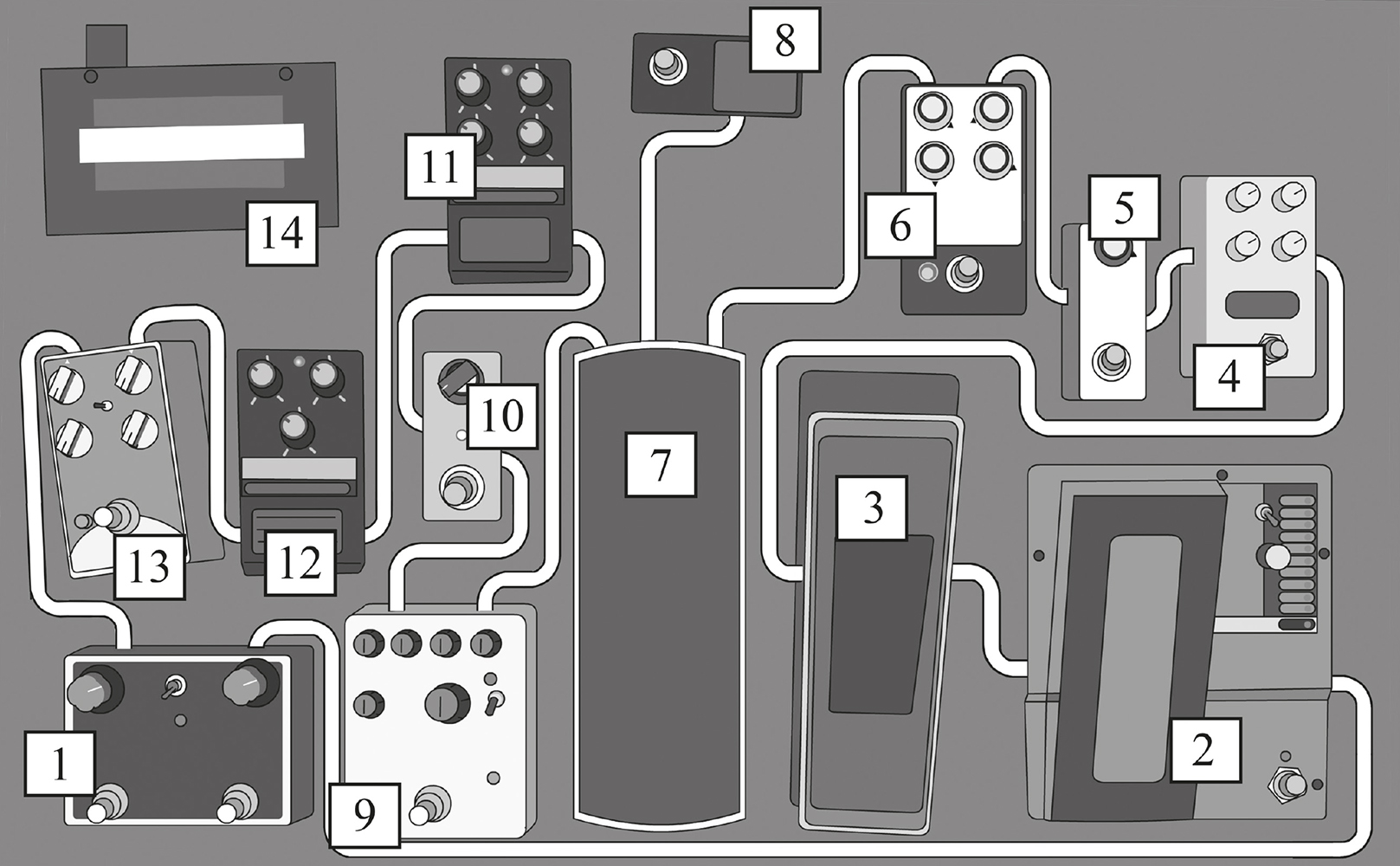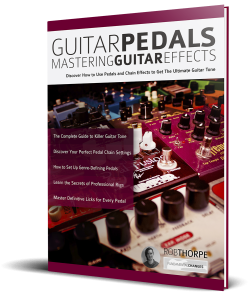
Anton Hunter
www.antonhunter.com / @hunteranton
First, we meet Manchester-based improvising guitarist Anton Hunter, guitarist for internationally touringBeats & Pieces Big Band, Sloth Racket and Article XI, as well as a host of other ad-hoc improvised groups.
You’re usually referred to as a “jazz” guitarist, so people might be surprised to see you use this setup if they haven’t heard your playing. Are there any guitarists who inspired you to go down this route?
I’ve always been into pedals and changing the sound of the guitar. When I was a youth that would have been bands like Radiohead & Mogwai, especially Jonny Greenwood, who get these huge walls of noise. It’s interesting delays and making a guitar sound like “not a guitar”. I was quite into Mick McCave from The Verve. Before Urban Hymns they were a four piece, A Northern Soul, and the album before [No Come Down] was delay-laden, so I got into delay pedals a lot.
In terms of people who would be identifiable as “jazz” guitarists, seeing local hero Stuart McCallum live when I was first getting into jazz was like “Oh, you CAN combine effects and jazz language or approaches.”Then Bill Frisell and Nels Cline, who both have a pedal collection that would put mine to shame. Yet, Billstill sounds like himself whether on an acoustic guitar or using loads of loops and delays, freeze pedals andwhatever, distortion, same with Nels Cline.
How did you arrive at your current extensive effects setup?
Gradually is the one-word answer. It’s evolved over a long time. I can’t remember when I got a flight-case and stuck things down, but for a long time I carried around a sports bag and set them all up each gig. I’d do it inbasically the conventional order, so pitch [shifting], distortion, then delay, roughly.
A while back I moved the volume pedal to after all the dirt, so you can get this: [plays a faded-in saturateddistortion chord]. So it’s already incredibly fuzzy before it starts fading in.
When I bought the Earthquaker Devices Levitation [reverb] everything had to make way and I realised Iwasn’t using the tremolo, so that went. It’s in a constant state of evolution, I guess.
You manipulate effect settings in real-time a lot while playing. Do you have a way of consciously practising this in a creative or technical way?
Definitely in a creative way. So, I’ll do what might be described as a solo ambient improvisation, with a loop pedal and delays. I hear this stuff when I’m improvising: “Oh, I want such and such,” or “I can hear thiscoming in” then I try to make it happen.
I’m not really a good user of the loop pedal rhythmically, partly because this Ditto is a one-button pedal sothere’s no separate stop button. That is something that I should practise from a technical standpoint.
Do you use any of the pedals in particularly unorthodox ways?
A lot of people would put the loop last in the signal chain – the idea being that you’ve got a sound and you want to loop it, so it goes last, especially if you’re building up layers into a composition.
Instead, I mostly use it for texture, but if I do use it for a repeating pattern, then I’ve got a flanger, delay and a reverb after it. That means each loop will be different if, for example, the flanger repeats on a different time period. It stops the ear getting bored by the repetition. That’s something about people using loops to build up compositions, it gets really boring because it’s just the same four bars round and round again. This is a way ofacknowledging that and being able to change how the loop sounds without starting and stopping it.
The Levitation Reverb from Earthquaker Devices has an “atmosphere” control which feeds the high frequencies back through the pedal again. Because the pedals are after the loop, I can stick the repeats right up, so it goes into self-oscillation, and you’ve got a really sophisticated fadeout, compared to just turning the loop pedal’s volume down, or stopping it dead.
The Saturn Works Feedback Looper is an effects loop for the whole pedalboard with a bypass and volume out. The other side is a momentary feedback looper that controls the amount of sound that goes back round into the start of the board. So, the Feedback Looper is able to turn off a big wall of noise, but also create it, which is really impractical and none of your readers will want to do this!
ANTON’S RIG
Click rig image below to enlarge
|
1 Saturn Works Feedback Looper |
8 TC Electronic Polytune |
|
2 Digitech Whammy V |
9 Red Panda Particle |
|
3 Vox Wah |
10 TC Electronic Ditto |
|
4 Empress Germ Drive |
11 Loco Box Flanger |
|
5 Z-Vex Super Hard-On (clone) |
12 Loco Box Analog Delay |
|
6 Earthquaker Devices Terminal |
13 Earthquaker Devices Levitation |
|
7 Ernie Ball Volume |
14 Voodoo Lab Pedal power 2 (power supply) |




